
11 Podcast Promotion Strategies for Explosive Results
By Daniel Ndukwu
Starting a podcast is only half the battle.
In order for it to be considered a success, it needs impressive download numbers.
There was a time when you could publish a lot of content and you’d be discovered. Now, the internet is crowded.

1. Make your guest a part of the process
Your guest shouldn’t be someone who comes, drops sage wisdom, then disappears when it’s time to do the heavy lifting of promotion.
Rather, they should be invested in the process and help you get the word out.
The problem is that people tend to leave their guests on their own and, at best, give them a link and ask them to share. While they may oblige you, there’s a better way.
Instead of just sending them a link when the show goes live, bring them into the process as an equal stakeholder.
Do this by creating collateral for them to share. Make graphics, break out sound bites, and create video clips your guest can use. Here are a few things that do well on social media:
- Quotes
- Soundbites (if you pull from SoundCloud and a few other podcast hosts and share to Twitter, it will play within the Twitter feed)
- Status updates for the major social platforms
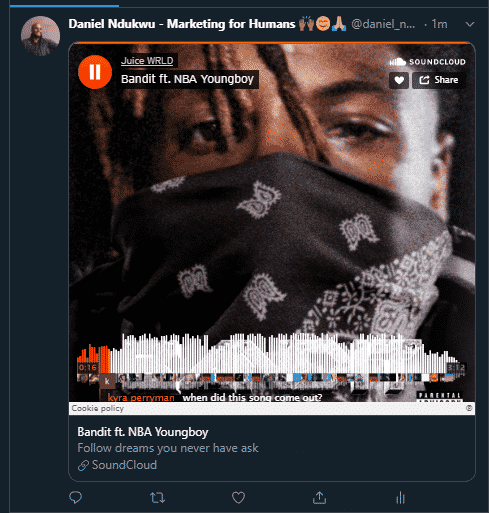
As long as you make it easy for them, there’s no reason for your guest to refuse to participate in the promotion.
2. Cross-promote to YouTube
Many people think YouTube is in direct opposition to podcasting. It’s not. YouTube can be an amazing source of new listeners and even revenue for your podcast.
There’s a right way and a wrong way to do it.
While you can upload a thumbnail and audio to YouTube, it’s unlikely to engage your audience. They’re better off listening to it through iTunes or Spotify.
The right way to do it comes in many different shapes and sizes.
Selecting the ideal voice-over is a fundamental aspect of the video production and improvement process.
This critical choice greatly influences the overall mood of the video, significantly affecting how the story connects with the viewers.
The goal extends beyond mere information dissemination; it's about forging a compelling and engaging narrative that not only reaches the audience but also deeply impacts their experience, ensuring the message is not just listened to, but profoundly experienced.
Record the conversation
This may be the best way to take advantage of YouTube as a cross-promotion platform. As you’re talking to your guest or even if you’re talking alone, record a video.
You can put it on YouTube in its entirety or you can pull out short clips from it and use it as a teaser of the entire video. These can be uploaded to YouTube as well as other places like Facebook or Vimeo.
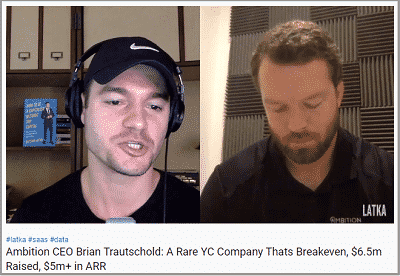
Create a promo video
This is different from the above tactic because you don’t necessarily have to record yourself.
Create a short clip with software like Wave.video or something similar that announces the new podcast episode.
You can even incorporate a few interesting quotes to get people excited about it.
This takes a bit more effort and you may have to bring in a contractor but is versatile because you can share the promo video across multiple platforms like Facebook, Twitter, and even Pinterest.
This Twitter cache strategy can add a dynamic twist to your promotional efforts. Instead of simply relying on text-based announcements, you can leverage the power of visuals and video clips to captivate your audience.
While this approach may demand a bit more effort and possibly the involvement of a contractor, it pays off by providing versatility. Your promo video can effortlessly find its place on various social platforms, not just Twitter but also Facebook, and even Pinterest, expanding your reach and engaging a broader audience.
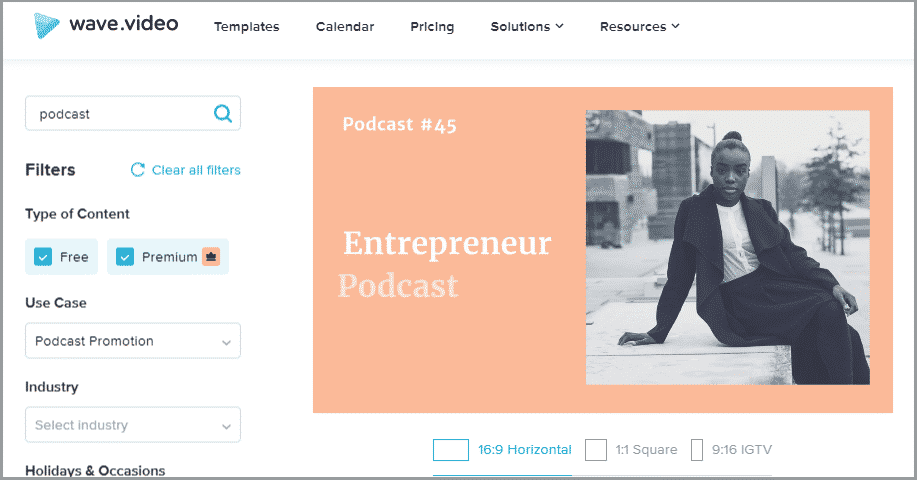
3. Take advantage of podcast aggregators
Podcast aggregators are your friends. Even though iTunes is possibly the most important platform for your podcast, discovery is a problem. Everyone else is also on iTunes.
You can circumvent this to an extent by adding your podcast to an aggregator that isn’t as crowded as iTunes but still has a decent amount of traffic.
People will find your show through the third party platform, still listen to it on iTunes or wherever it links back to, and help you climb the charts.
There are dozens of aggregators available today and more are springing up all the time. Also, try to look for niche aggregators. It’s better to list your gardening podcast on a niche-specific aggregator with 50,000 visitors a month than it is to list it on a general aggregator with 150,000 visitors a month.
With that being said, you can list it on both of them and reap the rewards of increased visibility and distribution. Here are some of the top podcast aggregators:
- Stitcher
- TuneIn Radio
- Spreaker
- Podcasts Alltop
4. Turn the audio to text and make amazing show notes
It’s said people don’t read on the internet.
That’s not true.
I read.
You’re reading this.
People are pickier about what they consume because there are so many distractions online.
With a podcast, not everyone will be able to listen to the episode. This could be for any number of reasons such as internet connectivity, preferences, or time constraints.
Whatever the case, the written content is an opportunity to reach a wider audience and increase the likelihood that you’ll rank well in the search engines.
A double whammy (do people still say that ??)
A popular podcast called Indie Hackers uses this strategy. The host gets the entire episode, which can run upwards of an hour, transcribed for a few dollars.
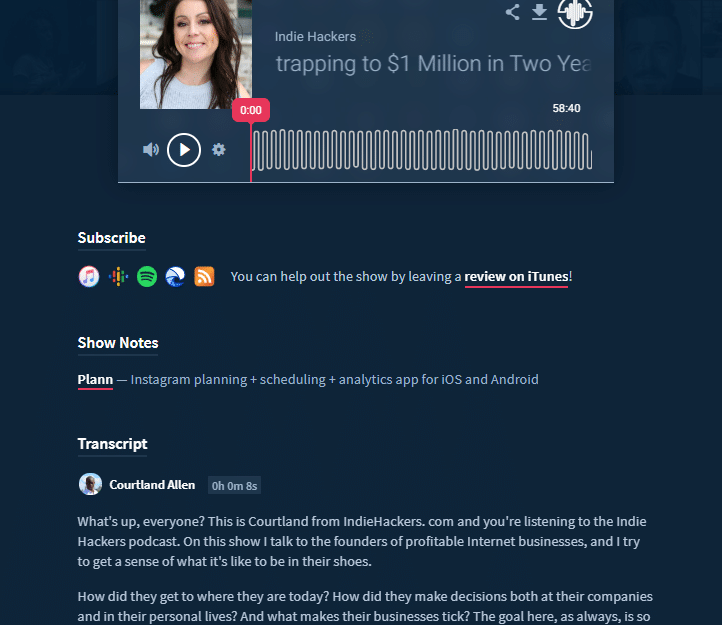
I’ve personally read through many of the interviews and even when listening, I’ll go back through the written version to catch key points I may have missed.
When going this route, be sure to add timestamps so if people want to listen to the audio version of the text, they can find the interesting points.
Another way to capitalize on using text is to create detailed show notes. This goes beyond a few time-stamped highlights. Focus on finding the key points from the podcast episode and turning them into actionable takeaways. Nick Loper from Side Hustle Nation does this well.
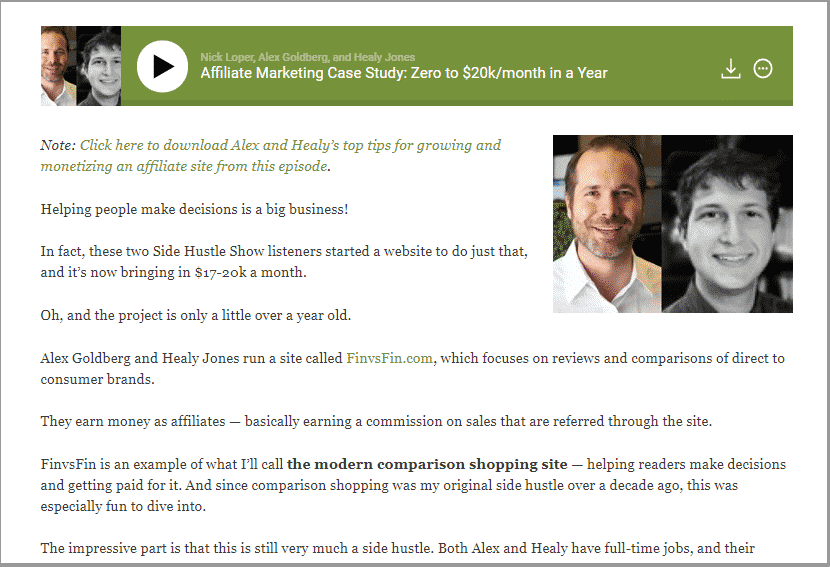
He also creates downloadable PDFs visitors get if they enter their email address. From there, he can send out an email to subscribers every time he releases a new show.
5. Run the occasional giveaway for podcast promotion
Running a giveaway may not be the first thing that comes to mind when you think about podcast promotion.
- What would you offer winners
- How would people enter
- Should you partner with someone
These are all valid questions and it’s what stops a lot of people from taking advantage of this powerful growth strategy. I’ll admit, we’ve had a love-hate relationship with giveaways in the past as well.
I digress.
Moving on.
The goal of your giveaway should be to get people to take an action which will help you increase the visibility of your podcast. In this case, that’s an iTunes review.
Ask people to leave an iTunes review in exchange for an entry into your giveaway. It’ll help you rise in the rankings and build visibility. It’s a small ask for free stuff.
Now, what free stuff should you give away? The specific items depend on the focus of your show but a few things that tend to work well are:
- Shirts
- Jackets
- Socks (I found this interesting too)
- Custom swag boxes
- Relevant software
- Books
- A short guest spot
- Mentions in the show notes or a feature on your website
The clothes can be branded with your podcast logo but make sure it’s high quality so it doesn’t get removed after a few washes. Here’s an example of a giveaway bundle from the folks over at Buffer.
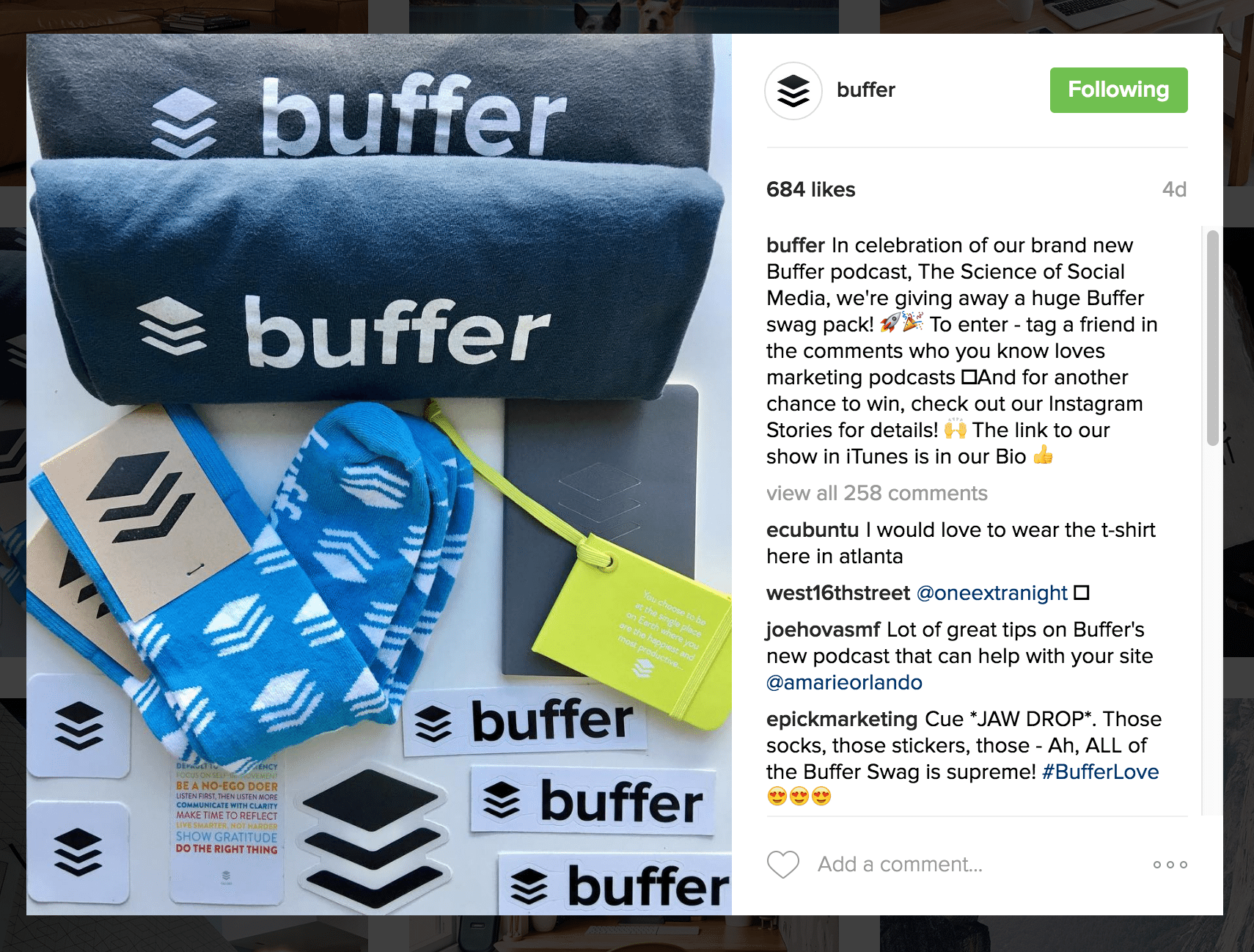
The challenge with the iTunes review is finding the reviewer afterward.
You can ask participants to leave one of their social media handles in the comments so you can find them. Make sure they don’t mention they’re leaving a review as a contest entry.
That would be awkward.
And think about tossing in a little extra to sweeten the deal. Like, offer them the chance to have their fave podcast episode transcribed for a few dollars. It's a win-win.
They get something cool, and you attract more folks joining in because it's right up their alley.
6. Reach out to people and companies mentioned
During most podcast episodes, especially in an interview format, other people, tools, and organizations are mentioned. Normally, those are linked in the show notes for people to check out if they’re interested.
Take this a step further by reaching out to whoever or whatever you linked in the show notes and let them know they were mentioned.
Let them know you’ve mentioned them, compliment them on the great work they’re doing, and invite them to check out the podcast episode. If they think it’s great, they’ll share it on their own.
Building on this tactic, you can also find people who’re in the industry and may be interested in your content. Create a list of them and start interacting with them via comments on their website, social media, etc.
Eventually, you’ll get on their radar and they’ll be more willing to share your stuff when you ask because you’re not a stranger.
7. Prioritize reviews
No matter what anyone tells you, reviews are the most impactful thing when it comes to increasing your podcast’s visibility.
You’re competing with hundreds of thousands of podcasts and there are about three things people use to choose your show:
- Your cover art
- Your description
- Your reviews and rating
Cover art and description are easy to tweak. It’s not so easy to get a large number of reviews unless you prioritize it. That’s why you should build the review collection process into your workflow.
Ask listeners
It’s always surprising how much you can accomplish by asking and giving a reason – any reason. In a study by Ellen Langer, it was found that she could increase the number of people who agreed to her wishes by adding a reason.
In the experiment, she asked people if she could cut in line. In a few instances, she gave a reason. In other instances, she didn’t give a reason. When she gave a reason, even if it was something as minuscule as “because I’m in a rush,” people would agree more often.
How does this apply to getting more iTunes reviews?
It shows that you can ask your listeners for a review and, if you offer a reason, you can increase the likelihood that they do it. The reason could be something as simple as “because it makes it easier for others to find us.”
Ask your network
Your network is the first place you should turn for reviews because they’re invested in your success. If they scratch your back, you’re more likely to scratch theirs. It’s the principle of reciprocity that has a place in web design, relationships, and getting reviews for your podcast.
How do you do it?
It’s the same way you would do it with your listeners – just ask. The difference is that you can be more direct about it.
8. Content marketing
First of all, producing a podcast is a form of content marketing so we’re going to exclude it from this conversation.
Instead, focus on the other aspects of content marketing to grow your podcast audience.
Video marketing:
Create short videos or record the entire podcast episode so people can connect with you on a deeper level.
The video above is a candid conversation that has over 10,000 views – in addition to the episode listens on iTunes.
Blogging:
If you’ve been online for any length of time then you’ve likely heard about the power of blogging. When you use it together with your podcast then great things can happen.
The key is to fill gaps in your podcast with blog content. For example, if you have a fitness-related podcast and interview guests, certain things won’t be covered.
A guest is unlikely to talk about the anatomy of the perfect pushup. Instead, they’ll focus on their journey.
Your blog can help you fill those gaps and also funnel people back to your podcast. You’ll get traffic from SEO and your rankings on podcast distribution platforms.
9. Build an email list
Email marketing is still the bread and butter of the online world. It’s the most intimate form of communication because it can make one to many messages feel like one to one.
There are many ways to grow your email list and a few of them have been mentioned in this guide already.
- Show notes as a lead magnet download
- Newsletter sign up
- Free course related to your podcast topic
- Content upgrades that expand on the podcast episode
Nat Eliason offers a way to sign up for his newsletter at the bottom of every podcast episode.

10. Create great content to promote your podcast
The final way to promote your podcast isn’t, technically, a promotion strategy but it’s the most essential.
You have to create great content. Now, the definition of great content is subjective. What’s great to me may be different from what’s great to the next person.
The key is to be great for the people you’re creating content for. Ask yourself, is what you’ve made and are making interesting to your target demographic.
- Will they learn something new
- Is it engaging for them
- Is the guest you’re talking to interesting
Come up with a few quality assurance guidelines that each episode should pass. If it doesn’t, scrap it and move on to the next one. You’re creating a body of work that will stand the test of time.
It’s what you’ll be judged on by close acquaintances and even strangers. There’s no point in putting subpar work out into the world.
Conclusion
Podcast promotion isn’t something that you do once and forget about. It’s a constant process that grows your audience and reach over time.
All of the strategies outlined here are things you’ll do every time you publish a new episode. It can seem tedious at first but you’ll eventually learn what has the greatest impact on your audience growth.
Prioritize that.
Copyright 2018 - 2020, KyLeads. All rights reserved.
